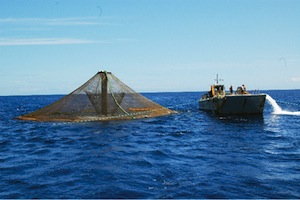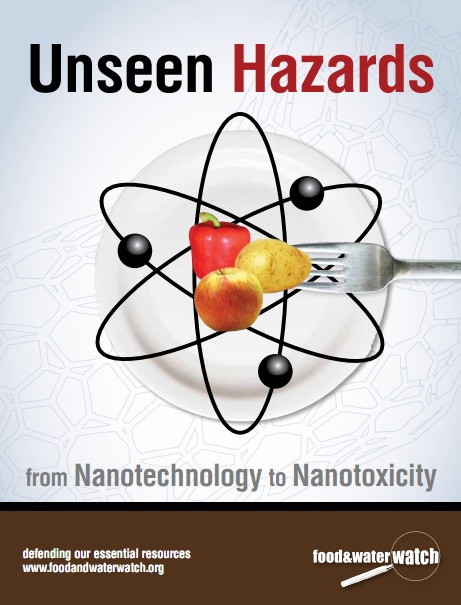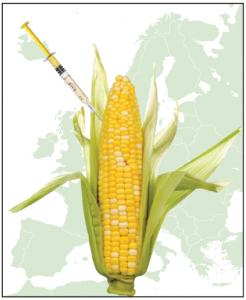 Offshore aquaculture is factory fish farming of the sea, growing fish in huge, often over-crowded cages out in ocean waters. It can be problematic for both the environment and the economy. The waste – fecal matter, uneaten food, and any chemicals or drugs used in the operation – flows directly into the ocean, and the result could be long-term damage to the seafloor. Despite its negative impacts, the following groups push for, or would profit from, factory fish farming in the United States and Europe.
Offshore aquaculture is factory fish farming of the sea, growing fish in huge, often over-crowded cages out in ocean waters. It can be problematic for both the environment and the economy. The waste – fecal matter, uneaten food, and any chemicals or drugs used in the operation – flows directly into the ocean, and the result could be long-term damage to the seafloor. Despite its negative impacts, the following groups push for, or would profit from, factory fish farming in the United States and Europe.
Blog Categories: environment
 Unfortunately, the enormous potential of nanotechnology to quell the world’s problems may be offset by its potential to cause harm. There is legitimate concern that the nano-sized particles employed in this new technology will have seriously damaging effects on the health of humans and the environment. Dozens of studies from the emerging field of nanotoxicity have already demonstrated hazards associated with nanoparticles.
Unfortunately, the enormous potential of nanotechnology to quell the world’s problems may be offset by its potential to cause harm. There is legitimate concern that the nano-sized particles employed in this new technology will have seriously damaging effects on the health of humans and the environment. Dozens of studies from the emerging field of nanotoxicity have already demonstrated hazards associated with nanoparticles.
We all know that driving a gas-guzzling SUV contributes to climate change,but did you know that what you put on your plate could too? Here’s how your food choices affect climate change and what you, as a consumer, can do about it.
DOWNLOAD PDF
 When you think of an embassy, you might think of diplomats dining with world leaders and consulate staffers assisting travelers who have lost their passports. Lately, however, ambassadors representing the United States have been carrying out a less traditional sort of mission in the European Union: promoting the interests of biotechnology companies and the genetically modified products they are attempting to sell around the world.
DOWNLOAD PDF
When you think of an embassy, you might think of diplomats dining with world leaders and consulate staffers assisting travelers who have lost their passports. Lately, however, ambassadors representing the United States have been carrying out a less traditional sort of mission in the European Union: promoting the interests of biotechnology companies and the genetically modified products they are attempting to sell around the world.
DOWNLOAD PDF
VIEW ON SCRIBD
Excerpt from the executive summary
Rising oil prices, energy security, and global warming concerns have all contributed to the current hype over biofuels. With both prices and demand for oil likely to continue to increase, biofuels are being presented as the way to curb greenhouse gas emissions and to develop homegrown energy that reduces our dependency on foreign oil.
| Related Documents |
|---|
In this context, corn-based ethanol has emerged as a leading contender to reduce dependence on fossil fuel,based gasoline. At first glance, corn,based ethanol seems simple, even patriotic: take the sugar from corn that U.S. farmers grow, and ferment it with yeast to distill basically the same stuff found in alcoholic beverages. By products, such as distiller‚ grain and corn gluten, serve as livestock feed and help offset refining costs. The industry claims that ethanol blends will lower tailpipe emissions, promote energy independence, and revitalize rural America.
Farmers and investors envision a new gold rush. Ethanol production is registering record growth rates, and reached nearly five billion gallons in 2006. Dozens of new ethanol refineries are being constructed, with production capacity forecast to double as early as 2008.1 President Bush intensified this momentum in his 2007 State of the Union address with a call to produce 35 billion gallons of alternative fuels by 2017 — a fivefold increase from the currently established goals.
However, the leading raw material for ethanol in the United States-corn-is among the least efficient, most polluting, and overall least sustainable biofuel feedstocks.
This report reviews the most up to date scientific evidence and concludes that corn-based ethanol is not the silver bullet everyone is seeking.



